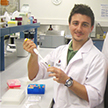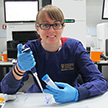Related Questions
- do you feel it is better to use man made drugs or herbal remedy to cure superbugs?
- why do we have to create man made drugs to battle the bugs/superbugs and diseases, why can't we let our own DNA
- Is there are cure for everything?
- when you discover how the on and off switches work, will you be able to help cancer pacients stop growing cancer cells?









So what you are talking about is clinical trials, which is where scientist first test new drugs on humans. Before this, they need to have tested on cell lines and got approval to test on an animal model of the disease they want to treat. This is often refered to as a preclinical trial, as it is before doctors in clinics can enlist patients. If that shows that the drug seems to work and without making the animals sick you progress to clinical trials. These are done in phases where if one phase shows promise with little side effects you can progress to the next.
according to the US national health institute these phases are defined as:
Phase I: Researchers test a new drug or treatment in a small group of people for the first time to evaluate its safety, determine a safe dosage range, and identify side effects.
Phase II: The drug or treatment is given to a larger group of people to see if it is effective and to further evaluate its safety.
Phase III: The drug or treatment is given to large groups of people to confirm its effectiveness, monitor side effects, compare it to commonly used treatments, and collect information that will allow the drug or treatment to be used safely.
At this point, the drugs can go to the drug safety board to be released for general use but that doesnt mean the testing is done! The company/lab then needs to do Phase IV trials to gather information on the drug’s effect in various populations and any side effects associated with long-term use.
tog vie you an idea, in the US 70% of phase one trials make it to phase II. 45% of those make it to phase III and 60% of those make it to the approval committee, and once there about 90% make it through to the market. overall only about 20% of drugs which start clinical trials make it to the market, ie to general patient treatment.
the current estimated cost for each drug that makes it to market in the US is 1.2 billion dollars.
0
Good question trockstar1, when scientist come up with a potential treatment (ie. drug), before we confirm our results we test it as many time as possible. If we confirm that the drug we are proposing is efficient to cure a disease then we get it ready for clinical trials:
Here we have 5 phases:
Phase 0: The drug is given to ~10-15 people to get a preliminary data on what the drug does the body and what your body does the drug
Phase 1: Safety screening – the drug is given to 20-80 people to determine how safe the drug is whether it has any side effect
Phase 2: Establishing the testing protocol – 100-300 people are given the drug
Phase 3: Final testing – 1000-3000 people are given the drug
If your drug is found really effective with insignificant side/adverse effects then it gets approved to be released to market. But even after market release, scientists continue to monitor drug’s effects on users which makes the Phase 4.
Phase 4: Postapproval studies
0
I think Miranda and Yagiz have covered this one pretty well. and the short answer is definitely a lot! We really need to make sure things a safe before they are made available to the public.
0